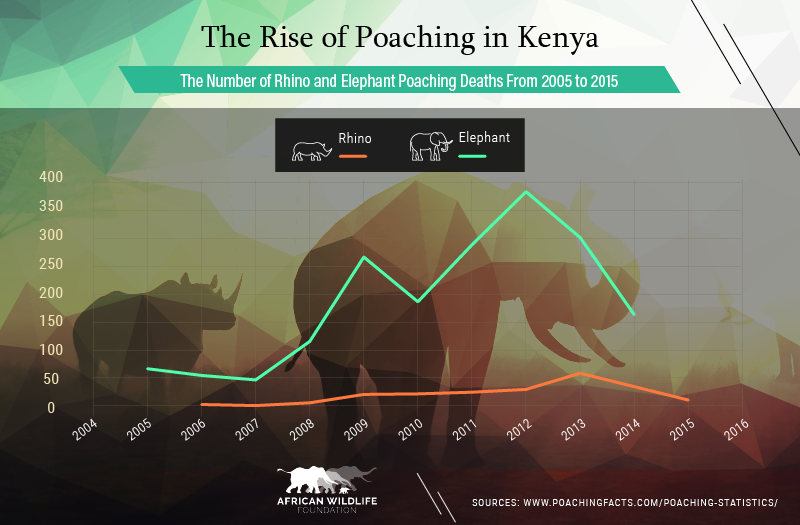
Poaching Statistics Overview
Few countries provide statistics on the number of poachers arrested or killed, wildlife illegally killed, or the number of rangers and other personnel killed in the line of duty. This page summarizes a variety of statistics available from reliable sources of hard data. PoachingFacts strives to use only a minimum of estimates based on peer-reviewed scientific studies when describing population increases or losses, preferring hard data when available.
Ivory poaching and the resulting trafficking is a widespread issue throughout all of Africa, but many nations are securing what populations they have left to safeguard the ecological heritage of their country as well as to retain a strong tourism industry. Many of these nations depend on their natural heritage to bring in tourists who greatly stimulate the economy.
Anti-Poaching Rangers Killed, Wildlife-Related Arrests Made
Sean Willmore, president of the International Ranger Federation and founder of the Thin Green Line Foundation, estimates that about 2 rangers are killed each week, but that the number could be higher. This number signifies individuals employed as anti-poaching rangers by profession, not military personnel or other individuals that might take part in ground or air operations.
Few countries publish crime statistics relating to the number of poachers arrested due to varying types of poaching, different penalties for different types of poaching, and potentially long trial processes. Below is data from countries that do provide such information on arrests.
Kenya: 1,549 suspects were arrested and prosecuted in 2013 (KWS Annual Report 2013, pg. 16) for environmental crimes. During that time 3 KWS rangers were killed in the line of duty and 2 were injured. According to the same report (page 15) arrests of poachers resulted in the recovery of 45 kilograms (99 pounds) of rhino horn, 10,106 kg (22,280 pounds) of bushmeat, and 23,145 kg (51,025 pounds) of ivory.
South Africa: In 2013 there were 343 poachers arrested or killed throughout the country. According to Major-General Johan Jooste 133 of those poachers were neutralized in Kruger National Park, with 47 of those individuals killed during shoot-outs with anti-poaching rangers. 386 suspected poachers were arrested during 2014; these represent rhino poachers and the couriers that carry the horn, poaching syndicate members, and criminal syndicate associates.
Overviews of Major Countries Reporting Transnational Wildlife Crime
Botswana: Home to roughly a third of Africa’s elephants, Botswana is more insulated from poaching than some of its neighbors but contends with cross-border poaching even while it assists other countries to replenish their natural populations through translocation programs. The government of Botswana has made several policy changes as it finds the best balance between strengthening its wildlife tourism industry and civil rights. Regional economic stability will aid in reducing cross-border poaching, but law enforcement and intelligence organizations must communicate and work together to prevent sophisticated criminal syndicates from taking root.
India: Home to a vast array of wildlife species that rivals the African continent’s, India continues to suffer from human-wildlife conflict, poverty, and challenges with communities living on the border of national parks. Like other countries in southern Asia it a growing poaching problem due to demand from Southeast Asian nations as well as criminal networks using bordering countries to launder protected wildlife parts and other illegal goods.
Kenya: Poaching and retribution killing of high value wildlife has shown several years of decline since its peak between 2011-2014. The Kenya Wildlife Service (KWS) has reported a notable decline in elephant and rhino poaching in recent years. Kenya still contends with balancing its land and water utilization between wildlife tourism and livestock grazing.
Mozambique: Due to its extreme poverty, unemployment, and lack of social programs, Mozambique acts as a haven for poachers and criminal syndicates that traffick ivory and rhino horn. Often low-level poachers operating out of Mozambique sell illegal wildlife parts to intermediaries who smuggle the parts out of Africa by air or sea. Mozambique releases little data on the elephants and rhino poached within its borders, but does employ heavily armed anti-poaching rangers.
Namibia: A very safe country for tourists and wildlife, Namibia has made use of a variety of methods to combat domestic and cross-border poaching of its wildlife. Namibia has had several years of record-setting poaching interspersed with years where few rhino or elephant were poached. This is a clear indicator of the necessity of economic stability of communities near wildlife parks.
South Africa: The home of the resurgence of both black rhinoceros and white rhinoceros populations in Africa, South Africa struggles with every form of poaching and wildlife trafficking at every scale. In 2014 the country reached the highest rhino mortalities ever recorded and attributed to poaching. Since then, efforts by public, private, and military have helped to reduce the number of instances of poaching of high-value wildlife, however criminal syndicates have become more aware of the weaknesses of South Africa’s national parks and nearby reserves and in recent years have set their sights on the less popular regions with less protection. Organized crime still thrives and government corruption and negligence remains a major obstacle to securing the lives of wildlife on public and private property.
Detailed Poaching Statistics
For more detailed statistics please visit the in-depth pages:

